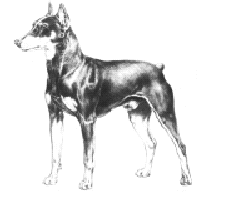German Pinscher
General Information - German Pinscher

Group:
Utility
Size:
medium
Lifespan:
12-14 years
Exercise:
high
Grooming:
very low
Trainability:
medium
Watchdog ability:
very high
Protection
ability:
low
Area of Origin:
Germany
Date of Origin:
1800s
Other Names:
Standard Pinscher,
Pinscher
Original Function:
ratting
History
The German Pinscher, also known as the Standard Pinscher or just the Pinscher, is a hardy multi-purpose breed which originated in 1800's Germany; it was originally used to hunt rats. Since it is large for a Terrier (Pinscher is German for terrier), it is often used as a general farm hand dog. It has the same elegant bearing and clean lines as the Dobermann but in a smaller version.
Temperament
The German Pinscher is alert and intelligent. It will respond well to firm obedience training, and because of its Terrier and Pinscher heritage, it will need firm handling to control around other dogs.
Upkeep
This alert and active breed can have its exercise needs met with a moderate walk on leash, good romp in the yard or an off-lead foray in a safe area. This is not a breed that should live outdoors, although it appreciates access to a yard during the day. It likes a warm, soft bed. Coat care is minimal.
German Pinscher
A breed standard is the guideline which describes the ideal characteristics, temperament, and appearance of a breed and ensures that the breed is fit for function with soundness essential. Breeders and judges should at all times be careful to avoid obvious conditions and exaggerations, as well as being mindful of features which could be detrimental in any way to the health, welfare or soundness of this breed.
Breed Standard - German Pinscher
 General Appearance:
General Appearance: Well balanced, smooth coated, medium size with elegant and flowing outlines but strong and well muscled.
Characteritics: Alert, good natured, playful. Loyal, watchful and fearless.
Temperament: High spirited and self:possessed.
Head and Skull: Seen from above and side resembles a blunt wedge. Strong but not heavy, elongated without pronounced occiput. Overall length in proportion to back (from withers to base of tail) is approximately 1:2. Top of muzzle parallel with extended line of unwrinkled flat forehead; slight but distinct stop. Cheek muscles strong but not prominent. Deep muzzle. Nose full and black; in reds, nose of corresponding shade. Lips tight and dark. Snippiness undesirable.
Eyes: Dark, of medium size, oval and directed forward. Eye rims tight.
Ears: Set high. V shaped, folded down close to head.
Mouth: Jaws strong with a perfect, regular and complete scissor bite, ie upper teeth closely overlapping lower teeth and set square to the jaws.
Neck: Elegant and strong. Neither short nor stout. Nape well arched. Skin of throat tight without dewlap.
Forequarters: Well laid shoulder with good but flat muscle. Forelegs straight viewed from all sides, parallel elbows are close to body.
Body: Chest moderately wide with flat ribs. Brisket extends below elbow. Forechest extends beyond point of shoulder. Compact and short coupled. Length of body approximately equal to height at withers. Back short and slightly sloping. Slightly rounded coup.
Hindquarters: Seen from behind parallel, with sufficient width. Upper thigh slanted and strongly muscled. Good length and bend of stifle, hocks turning neither in nor out.
Feet: Well arched, compact and cat:like with dark nails. Turning neither in nor out. Tough, hard pads.
Tail: Set and carried high. Customarily docked to 3 joints.
Gait/movement: Free, well balanced and vigorous with good reach in front and strong rotary driving action from rear. Front and hind legs should not be thrown outwards. Topline should remain strong and firm. Hackney movement undesirable.
Coat: Short and dense, smoothly fitting, glossy without bald spots.
Colour: All solid colours from fawn (Isabella) to stag red in various shades. Black and blue with reddish/tan markings. In bi-coloured dogs sharply marked red/tan markings desirable. Markings distributed as follows: at cheeks, lips, lower jaw, above eyes, at throat, at forechest as two triangles separated from each other, at metatarsus, forelegs, feet, inner side of hindlegs and vent region.
Size: Height at withers 43:48 cms (17:19 ins).
Faults: Any departure from the foregoing points should be considered a fault and the seriousness with which the fault should be regarded should be in exact proportion to its degree.
Note: Male animals should have two apparently normal testicles fully descended into the scrotum.
DNZ No 634
FCI No 184
Copyright Dogs New Zealand
19 Dec 2013
Any departure from the foregoing points should be considered a fault and the seriousness with which the fault should be regarded should be in exact proportion to its degree and its effect upon the health and welfare of the dog and on the dog’s ability to perform its traditional work.




